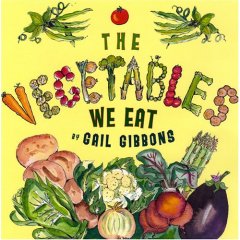
Sometimes a Gail Gibbons book is exactly what you (and your preschool-aged child) want: colorful, concise, and informative. This one is about The Vegetables We Eat (Holiday House, 2007). It might be more accurate to say that it's about some vegetables we eat and some I wish the kids would eat more of, but in any case, it's just the thing to read alongside the big stack of seed catalogs that have been coming in the mail since December 24 (our favorite is Seeds of Change; the 2008 catalog focuses on urban gardening). Now we know that there are eight different kinds of vegetables, grouped according to the part of the vegetable that is eaten (leaf, bulb, flower bud, root, tuber, stem, fruit, and seed). Which ones do we eat? Which ones will we grow? Gibbons also covers how vegetables are grown (on small and "great big" vegetable farms, as well as in your own garden), where they are sold (at farmers' markets and grocery stores), and how they're eaten. Watercolor and ink illustrations are bright and cheeful; I love the vegetables that spell out "Vegetables" on the cover.
[I can't resist suggesting that you pair The Vegetables We Eat with Caldecott Honor book Tops and Bottoms by Janet Stevens (Harcourt, 1995). My kids just discovered this book (our library bought a new copy, I assume because the old one was worn out from being read so much). It's a trickster tale with roots in slave stories of the American South: clever Hare agrees to split successive harvests with lazy Bear, tops and bottoms. Which crops does Hare grow for their bottoms? Which ones does he grow for their tops?]